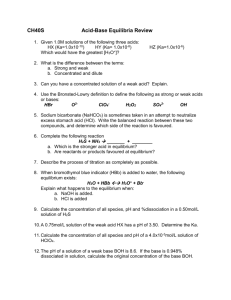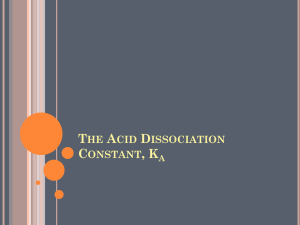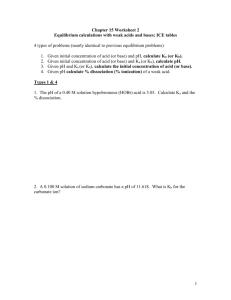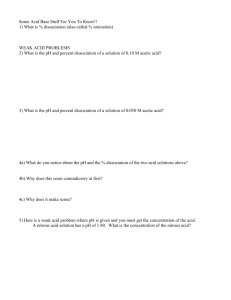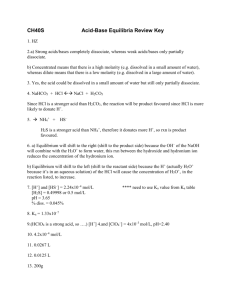Ka of Acetic Acid
advertisement
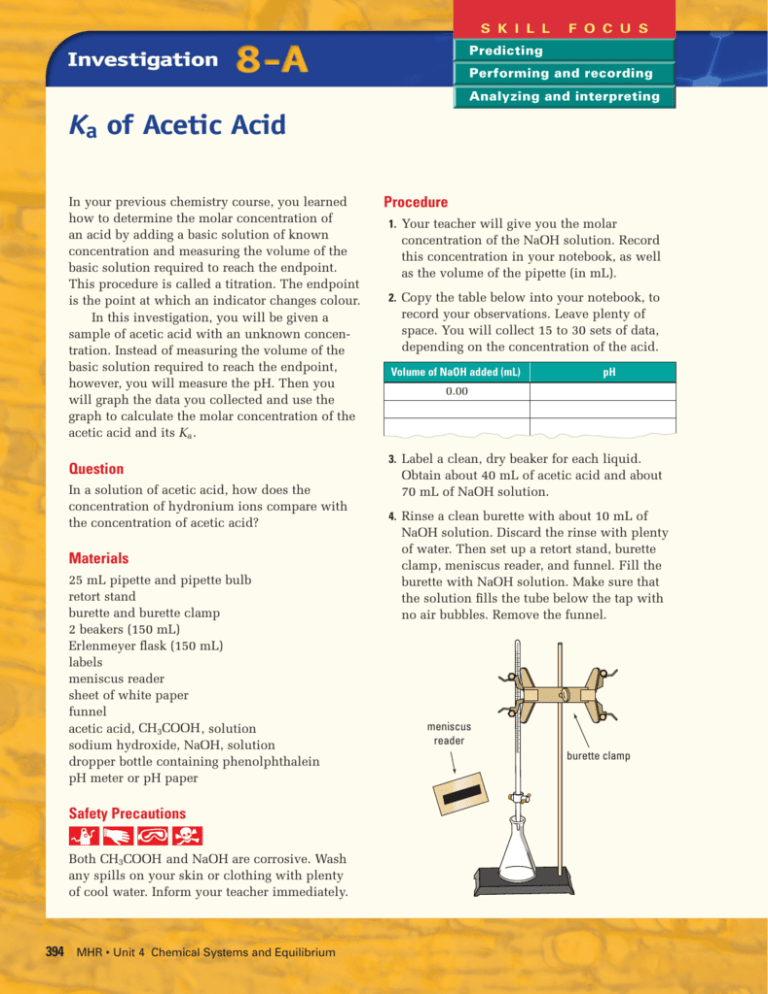
S K I L L F O C U S Predicting Performing and recording Analyzing and interpreting Ka of Acetic Acid In your previous chemistry course, you learned how to determine the molar concentration of an acid by adding a basic solution of known concentration and measuring the volume of the basic solution required to reach the endpoint. This procedure is called a titration. The endpoint is the point at which an indicator changes colour. In this investigation, you will be given a sample of acetic acid with an unknown concentration. Instead of measuring the volume of the basic solution required to reach the endpoint, however, you will measure the pH. Then you will graph the data you collected and use the graph to calculate the molar concentration of the acetic acid and its Ka . Question In a solution of acetic acid, how does the concentration of hydronium ions compare with the concentration of acetic acid? Materials 25 mL pipette and pipette bulb retort stand burette and burette clamp 2 beakers (150 mL) Erlenmeyer flask (150 mL) labels meniscus reader sheet of white paper funnel acetic acid, CH3COOH, solution sodium hydroxide, NaOH, solution dropper bottle containing phenolphthalein pH meter or pH paper Safety Precautions Both CH3COOH and NaOH are corrosive. Wash any spills on your skin or clothing with plenty of cool water. Inform your teacher immediately. 394 MHR • Unit 4 Chemical Systems and Equilibrium Procedure 1. Your teacher will give you the molar concentration of the NaOH solution. Record this concentration in your notebook, as well as the volume of the pipette (in mL). 2. Copy the table below into your notebook, to record your observations. Leave plenty of space. You will collect 15 to 30 sets of data, depending on the concentration of the acid. Volume of NaOH added (mL) pH 0.00 3. Label a clean, dry beaker for each liquid. Obtain about 40 mL of acetic acid and about 70 mL of NaOH solution. 4. Rinse a clean burette with about 10 mL of NaOH solution. Discard the rinse with plenty of water. Then set up a retort stand, burette clamp, meniscus reader, and funnel. Fill the burette with NaOH solution. Make sure that the solution fills the tube below the tap with no air bubbles. Remove the funnel. meniscus reader burette clamp 5. Obtain a clean 25 mL pipette and a suction bulb. Rinse the pipette with 5 mL to 10 mL of CH3COOH, and discard the rinse with plenty of water. Pipette 25.00 mL of CH3COOH into an Erlenmeyer flask. Add two or three drops of phenolphthalein indicator. 6. Record the initial pH of the solution. Make sure that the glass electrode is immersed deeply enough to get an accurate reading. If necessary, tip the flask to one side. Place a sheet of white paper under the flask. 7. Add 2 mL of NaOH from the burette. Record the volume carefully, correct to two decimal places. Swirl the contents of the Erlenmeyer flask, then measure the pH of the solution. 8. Repeat step 7 until the pH rises above 2.0. Add 1 mL amounts until the pH reaches 5.0. 9. Above pH = 5.0, add NaOH in 0.2 mL or 0.1 mL portions. Continue to swirl the contents of the flask and take pH readings. Record the volume at which the phenolphthalein changes from colourless to pink. 10. Above pH = 11, add 1 mL portions until the pH reaches at least 12. 11. Wash the liquids down the sink with plenty of water. Rinse the pipette and burette with distilled water. Leave the burette tap open. 3. Calculate the molar concentration of the CH3COOH. Use the ratio in which the acid and base react, determined from the chemical equation. You can use the following equation to find the amount of a chemical in solution. Amount (in mol) = Concentration (in mol/L) × Volume (in L) Determine the amount of NaOH added, using its concentration (given by your teacher) and the volume on your graph (from question 2). 4. Write the expression for Ka for the dissocia- tion of CH3COOH in water. 5. Use the initial pH of the CH3COOH (before you added any base) to find the initial [H3O+ ]. What was the initial [CH3COO− ]? 6. Assume that the amount of CH3COOH that dissociates is small compared with the initial concentration of the acid. If this is true, the equilibrium value of [CH3COOH] is equal to the initial concentration of the acid. Use your values of [H3O+ ], [CH3COO− ], and [CH3COOH] to calculate Ka for acetic acid. Hint: [H3O+] = [CH3COO−] 7. Refer to the volume of NaOH on your graph (from question 2). Calculate half this volume. On your graph, find the pH when the solution was half-neutralized. 8. Calculate [H3O+ ] when the CH3COOH was Analysis 1. Write the chemical equation for the neutralization reaction you observed. 2. Plot a graph of your data, with pH on the vertical axis and volume of NaOH on the horizontal axis. Your graph should show a steep rise in pH as the volume of NaOH becomes enough to neutralize all the CH3COOH. Take the midpoint on the graph (where the graph rises steeply) and read off the volume of NaOH. This is the volume of NaOH that was needed to neutralize all the CH3COOH. Compare the volume on your graph with the volume you recorded when the phenolphthalein indicator first turned pink. half-neutralized. How does this value compare with your value of Ka for CH3COOH? Conclusion 9. Calculate the percent difference between your value for Ka and the accepted value. State two sources of error that might account for any differences. Application 10. Do the values you calculated for [H3O+ ] and [CH3COOH] prove that CH3COOH is a weak acid? Explain. Chapter 8 Acids, Bases, and pH • MHR 395 pH and Ka of a Weak Acid Table 8.2 lists the acid dissociation constants for selected acids at 25˚C. Notice that weak acids have Ka values that are between 1 and about 1 × 10−16 . Very weak acids have Ka values that are less than 1 × 10−16 . The smaller the value of Ka , the less the acid ionizes in aqueous solution. Problems that involve the concentrations of ions formed in aqueous solutions are considered to be equilibrium problems. The steps for solving acid and base equilibrium problems are similar to the steps you learned in Chapter 7 for solving equilibrium problems. Solving Equilibrium Problems That Involve Acids and Bases The steps that you will use to solve acid and base equilibrium problems will vary depending on the problem. Below are a few general steps to guide you. • Write the chemical equation. Use the chemical equation to set up an ICE table for the reacting substances. Enter any values that are given in the problem. (Note: For the problems in this textbook, you can assume that the concentrations of hydronium ions and hydroxide ions in pure water are negligible compared with the concentrations of these ions when a weak acid or weak base is dissolved in water.) • Let x represent the change in concentration of the substance with the smallest coefficient in the chemical equation. • For problems that give the initial concentration of the acid, [HA], compare the initial concentration of the acid with the acid dissociation constant, Ka . [HA] > 500, the change in the initial concentration, x, is Ka negligible and can be ignored. • If [HA] < 500, the change in the initial concentration, x, may Ka not be negligible. The equilibrium equation will be more complex, possibly requiring the solution of a quadratic equation. • If Table 8.2 Some Acid Dissociation Constants for Weak Acids at 25˚C Acid Formula Acid dissociation constant, Ka acetic acid CH3COOH 1.8 × 10−5 chlorous acid HClO2 1.1 × 10−2 formic acid HCOOH 1.8 × 10−4 hydrocyanic acid HCN 6.2 × 10−10 hydrofluoric acid HF 6.6 × 10−4 hydrogen oxide (water) H2O 1.0 × 10−14 lactic acid CH3CHOHCOOH 1.4 × 10−4 nitrous acid HNO2 7.2 × 10−4 phenol C6H5OH 1.3 × 10−10 396 MHR • Unit 4 Chemical Systems and Equilibrium Percent Dissociation The percent dissociation of a weak acid is the fraction of acid molecules that dissociate compared with the initial concentration of the acid, expressed as a percent. (Some chemists refer to percent dissociation as percent of dissociation.) The percent dissociation depends on the value of Ka for the acid, as well as the initial concentration of the weak acid. The following Sample Problems show how to solve problems that involve percent dissociation. Sample Problem Determining Ka and Percent Dissociation Problem Propanoic acid, CH3CH2COOH , is a weak monoprotic acid that is used to inhibit mould formation in bread. A student prepared a 0.10 mol/L solution of propanoic acid and found that the pH was 2.96. What is the acid dissociation constant for propanoic acid? What percent of its molecules were dissociated in the solution? What Is Required? You need to find Ka and the percent dissociation for propanoic acid. What Is Given? You have the following data: Initial [CH3CH2COOH] = 0.10 mol/L pH = 2.96 Plan Your Strategy Step 1 Write the equation for the dissociation equilibrium of propanoic acid in water. Then set up an ICE table. Step 2 Write the equation for the acid dissociation constant. Substitute equilibrium terms into the equation. Step 3 Calculate [H3O+ ] using [H3O+] = 10−pH Step 4 Use the stoichiometry of the equation and [H3O+ ] to substitute for the unknown term, x, and calculate Ka . Step 5 Calculate the percent dissociation by expressing the fraction of molecules that dissociate out of 100. Act on Your Strategy Step 1 Use the equation for the dissociation equilibrium of propanoic acid in water to set up an ICE table. Concentration (mol/L) Initial Change Equilibrium CH3CH2COOH(aq) + H 2 O ( ) CH3CH2COO−(aq) + H3O+(aq) 0.10 0 ~0 −x +x +x 0.10 − x +x +x Continued ... Chapter 8 Acids, Bases, and pH • MHR 397 Continued ... [CH3CH2COO−][H3O+] CH3CH2COOH] (x)(x) = (0.10 − x) Step 2 Ka = Step 3 The value of x is equal to [H3O+ ] and [CH3CH2COOH]. [H3O+] = 10−2.96 = 1.1 × 10−3 mol/L (1.1 × 10−3)2 0.10 − (1.1 × 10−3) = 1.2 × 10−5 1.1 × 10−3 mol/L × 100 Step 5 Percent dissociation = 0.10 mol/L = 1.1% Step 4 Ka = Check Your Solution The value of Ka and the percent dissociation are reasonable for a weak acid. Sample Problem Calculating pH Problem Formic acid, HCOOH, is present in the sting of certain ants. What is the pH of a 0.025 mol/L solution of formic acid? What Is Required? You need to calculate the pH of the solution. What Is Given? You know the concentration of formic acid: [HCOOH] = 0.025 mol/L The acid dissociation constant for formic acid is listed in Table 8.2: Ka = 1.8 × 10−4 Plan Your Strategy Step 1 Write the equation for the dissociation equilibrium of formic acid in water. Then set up an ICE table. Step 2 Write the equation for the acid dissociation constant. Substitute equilibrium terms into the equation. [HCOOH] Step 3 Check the value of to see whether or not the amount Ka that dissociates is negligible compared with the initial concentration of the acid. Step 4 Solve the equation for x. If the amount that dissociates is not negligible compared with the initial concentration of acid, you will need to use a quadratic equation. Step 5 pH = −log [H3O+] 398 MHR • Unit 4 Chemical Systems and Equilibrium Act on Your Strategy Step 1 HCOOH(aq) + H2O() Concentration (mol/L) Initial 0.025 0 ~0 −x +x +x 0.025 − x +x +x Change Equilibrium HCOO−(aq) + H3O+(aq) [HCOO−][H3O+] [HCOOH] (x)(x) = (0.025 − x) = 1.8 × 10−4 Step 2 Ka = Step 3 [HCOOH] 0.025 = Ka 1.8 × 10−4 = 139 Since this value is less than 500, the amount that dissociates is not negligible compared with the initial concentration of the acid. Step 4 Rearrange the equation into a quadratic equation. x2 = 1.8 × 10−4 (0.025 − x) x 2 + (1.8 × 10−4)x − (4.5 × 10−6) = 0 √ −b ± b2 − 4ac x= 2a √ −(1.8 × 10−4) ± (1.8 × 10−4)2 − 4 × 1 × (−4.5 × 10−6) = 2×1 x = 0.0020 or x = −0.002 The negative value is not reasonable, since a concentration term cannot be negative. ∴ x = 0.0020 mol/L = [H3O+] Step 5 pH = −log 0.0020 = 2.70 The pH of a solution of 0.025 mol/L formic acid is 2.70. Check Your Solution The pH indicates an acidic solution, as expected. Data that was given in the problem has two significant digits, and the pH has two digits following the decimal place. It is easy to make a mistake when solving a quadratic equation. You can estimate a solution to this problem, by assuming that (0.025 − x) is approximately equal to 0.025. x2 = 1.8 × 10−4 0.025 x 2 = 4.5 × 10−6 x = 2.1 × 10−3 mol/L This answer is very close to the answer obtained by solving the quadratic equation. Therefore, the solution is probably correct. Chapter 8 Acids, Bases, and pH • MHR 399 Practice Problems 19. Calculate the pH of a sample of vinegar that contains 0.83 mol/L acetic acid. What is the percent dissociation of the vinegar? 20. In low doses, barbiturates act as sedatives. Barbiturates are made from barbituric acid, a weak monoprotic acid that was first prepared by the German chemist Adolph von Baeyer in 1864. The formula of barbituric acid is C4H4N2O3 . A chemist prepares a 0.10 mol/L solution of barbituric acid. The chemist finds the pH of the solution to be 2.50. What is the acid dissociation constant for barbituric acid? What percent of its molecules dissociate? 21. A solution of hydrofluoric acid has a molar concentration of 0.0100 mol/L. What is the pH of this solution? 22. Hypochlorous acid, HOCl, is used as a bleach and a germ-killer. A chemist finds that 0.027% of hypochlorous acid molecules are dissociated in a 0.40 mol/L solution of the acid. What is the value of Ka for the acid? 23. The word “butter” comes from the Greek butyros. Butanoic acid (common name: butyric acid) gives rancid butter its distinctive odour. Calculate the pH of a 1.0 × 10−2 mol/L solution of butanoic acid (Ka = 1.51 × 10−5 ). 24. Caproic acid, C5H11COOH, occurs naturally in coconut and palm oil. It is a weak monoprotic acid, with Ka = 1.3 × 10−5 . A certain aqueous solution of caproic acid has a pH of 2.94. How much acid was dissolved to make 100 mL of this solution? Polyprotic Acids As you know, polyprotic acids have more than one hydrogen atom that dissociates. Each dissociation has a corresponding acid dissociation constant. How can you calculate the pH of a solution of a polyprotic acid? Problems that involve polyprotic acids can be divided into as many sub-problems as there are hydrogen atoms that dissociate. The ion concentrations that are calculated for the first dissociation are substituted as initial ion concentrations for the second dissociation, and so on. You can see this in the following Sample Problem. Sample Problem Calculations That Involve Polyprotic Acids Problem Phosphoric acid, H3PO4 , is one of the world’s most important industrial chemicals. It is mainly used to manufacture phosphate fertilizers. It is also the ingredient that gives cola drinks their tart, biting taste. Calculate the pH, [H2PO4− ], and [HPO42− ] of a 3.5 mol/L aqueous solution of phosphoric acid. What Is Required? You need to find pH and [H2PO4− ]. 400 MHR • Unit 4 Chemical Systems and Equilibrium What Is Given? You know that [H3PO4] = 3.5 mol/L. From data tables, you can find Ka1 = 7.0 × 10−3 and Ka2 = 6.3 × 10−8 . Plan Your Strategy Step 1 Write the equation for the dissociation equilibrium of phosphoric acid in water. Then set up an ICE table. Step 2 Write the dissociation equation for Ka1. Step 3 Determine whether or not the dissociation of H3PO4 is negligible, compared with the initial concentration. Step 4 Solve the equation for x. Step 5 Write the equation for the dissociation equilibrium of H2PO4− in water. Set up an ICE table using the concentrations you calculated for the first dissociation as initial concentrations here. Step 6 Write the dissociation equation for Ka2. Step 7 Determine whether or not the dissociation of H2PO4− is negligible, compared with the initial concentration. Step 8 Solve the equation for x. Step 9 Calculate [H3O+ ] and pH. Step 10 Calculate [H2PO4− ]. Act on Your Strategy Step 1 Concentration (mol/L) H3PO4(aq) + H2O() H2PO4−(aq) + H3O+(aq) Initial 3.5 0 ~0 Change −x +x +x 3.5 − x x x Equilibrium [H2PO4−][H3O+] [H3PO4] = 7.0 × 10−3 (x)(x) = (3.5 − x) Step 2 Ka1 = Step 3 [H3PO4] 3.5 = Ka1 7.0 × 10−3 = 500 Therefore, x is probably negligible, compared with 3.5. x2 3.5 x = 0.16 mol/L Step 4 7.0 × 10−3 = Step 5 Concentration (mol/L) Initial Change Equilibrium 2− + H2PO4−(aq) + H2O() HPO4 (aq) + H3O (aq) 0.16 0 0.16 −x +x +x 0.16 − x x (0.16 + x) Continued ... Chapter 8 Acids, Bases, and pH • MHR 401 Step 6 Ka2 = = Step 7 [HPO42−][H3O+] [H2PO4−] (x)(0.16 + x) (0.16 − x) [H2PO4−] 0.16 = = 2.5 × 106 Ka2 6.3 × 10−8 This is much greater than 500, so x is negligible compared with 0.16. Step 8 Ka2 = 6.3 × 10−8 = (x)(0.16) =x (0.16) x = [HPO42−] = 6.3 × 10−8 Step 9 pH = −log 0.16 = 0.80 Step 10 [H2PO4−] = 0.16 − x = 0.16 (because x is negligible) Check Your Solution [H3O+ ] results from the first dissociation of phosphoric acid, so the second dissociation has a negligible effect on the concentration of hydronium ions or the pH of the solution. You would expect this, because the second dissociation is much weaker than the first. Polyprotic Acids and [H3O+] All polyprotic acids, except sulfuric acid, are weak. Their second dissociation is much weaker than their first dissociation. For this reason, when calculating [H3O+ ] and pH of a polyprotic acid, only the first dissociation needs to be considered. The calculation is then the same as the calculation for any weak monoprotic acid. In the Sample Problem, [HPO42− ] was found to be the same as the second dissociation constant, Ka2. The concentration of the anions formed in the second dissociation of a polyprotic acid is equal to Ka2. The only common strong polyprotic acid is sulfuric acid. Nevertheless, it is strong only for the first dissociation. Like the second dissociation of other polyprotic acids, the second dissociation of sulfuric acid is weak. H2SO4(aq) + H2O() → HSO4−(aq) + H3O+(aq) HSO4−(aq) + H2O() SO42−(aq) + H3O+(aq) 100% dissociation Ka = 1.0 × 10−2 [H3O+ ] in a solution of sulfuric acid is equal to the concentration of the acid. Only in dilute solutions (less than 1.0 mol/L) does the second dissociation of sulfuric acid contribute to the hydronium ion concentration. Practice Problems 25. Carbonated beverages contain a solution of carbonic acid. Carbonic acid is also important for forming the ions that are present in blood. H2CO3(aq) CO2(aq) + H2O() H2CO3(aq) + H2O() HCO3−(aq) + H3O+(aq) Ka1 = 4.5 × 10−7 CO32−(aq) + H3O+(aq) Ka2 = 4.7 × 10−11 HCO3−(aq) + H2O() 402 MHR • Unit 4 Chemical Systems and Equilibrium Calculate the pH of a solution of 5.0 × 10−4 mol/L carbonic acid. What is [CO32− ] in the solution? 26. Adipic acid is a diprotic acid that is used to manufacture nylon. Its formula can be abbreviated to H2Ad. The acid dissociation constants for adipic acid are Ka1 = 3.71 × 10−5 and Ka2 = 3.87 × 10−6 . What is the pH of a 0.085 mol/L solution of adipic acid? 27. Hydrosulfuric acid, H2S(aq), is a weak diprotic acid that is sometimes used in analytical work. It is used to precipitate metal sulfides, which tend to be very insoluble. Calculate the pH and [HS−(aq)] of a 7.5 × 10−3 mol/L solution. 28. What is the value of Ka when water acts as a Brønsted-Lowry acid? Write the expression for Ka2 if water acts as a diprotic acid. Section Summary In this section, you learned about the relationship between the pH scale and the concentrations of the ions that form when water and weak acids dissociate. In the next section, you will learn that the equilibrium of weak bases is similar to the equilibrium of weak acids. As you will see, solutions that contain a mixture of a weak acid and a salt of its conjugate base have properties with important biochemical and industrial applications. Section Review 1 K/U Complete the following table by calculating the missing values and indicating whether each solution is acidic or basic. [H3O+] (mol/L) 3.7 × 10 (e) −5 pH [OH−] (mol/L) pOH (a) (b) (c) (d) 10.41 (f ) (g) (h) (k) (l) 8.9 (p) (i) (j) (m) (n) 7.0 × 10 (o) −2 Acidic or basic? 2 I Lactic acid, CH3CHOHCOOH, is a monoprotic acid that is produced by muscle activity. It is also produced from milk by the action of bacteria. What is the pH of a 0.12 mol/L solution of lactic acid? 3 A 0.10 mol/L solution of a weak acid was found to be 5.0% dissociated. Calculate Ka . 4 Oxalic acid, HOOCCOOH, is a weak diprotic acid that occurs naturally in some foods, including rhubarb. Calculate the pH of a solution of oxalic acid that is prepared by dissolving 2.5 g in 1.0 L of water. What is the concentration of hydrogen oxalate, HOOCCOO−, in the solution? 5 I A sample of blood was taken from a patient and sent to a laboratory for testing. Chemists found that the blood pH was 7.40. They also found that the hydrogen carbonate ion concentration was 2.6 × 10−2 mol/L. What was the concentration of carbonic acid in the blood? I I Chapter 8 Acids, Bases, and pH • MHR 403
